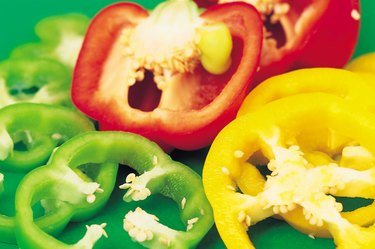
Vitamin B-6 is a water-soluble vitamin that must be obtained through dietary sources, according to the Linus Pauling Institute. Recommendations are made for vitamin B-6 and other vitamins to ensure adequate intake. Seek a registered dietitian for the best food sources that contain adequate amounts of vitamin B-6.
Recommendation
Video of the Day
Vitamin B-6 is involved in many vital functions in the body, so a recommended dietary allowance, or RDA, is established to prevent deficiencies. The National Institutes of Health reports that the RDA for vitamin B-6 is 1.3 milligrams to 1.7 milligrams for men and women. Pregnant and lactating women are required to get 1.9 to 2 milligrams of vitamin B-6, according to the NIH.
Video of the Day
Deficiencies
Deficiencies of vitamin B-6 are not common in the typical American diet, but alcoholics are considered to be the most at risk because of their poor nutrition and impaired metabolism due to the effects of alcohol, reports the Linus Pauling Institute. The NIH reports that older adults and people with limited diets also might be at risk for deficiency. Symptoms of vitamin B6 deficiency include depression, confusion and ulcers of the mouth, according to the LPI.
Function
The National Institutes of Health reports that vitamin B-6 is necessary for the function of more than 100 enzymes involved in the metabolism of protein. Vitamin B-6 also is required for a wide range of roles, such as healthy nervous system and immune system functioning. Red blood cells require vitamin B-6 for the production of hemoglobin in order to transport oxygen throughout tissues, reports the NIH. The Linus Pauling Institute reports that vitamin B-6 also is needed for the conversion of tryptophan to niacin, another vital B vitamin.
Sources
Vitamin B-6 is found in the highest concentrations in foods such as bananas, chickpeas, tuna and squash reports the National Institutes of Health Office of Dietary Supplements. Other dietary sources of include cabbage, asparagus, kale, broccoli, mushrooms and cauliflower. Fish such as salmon and cod also provide good amounts of the vitamin. Fortified food products such as cereals and grains contain traces of vitamin B-6 as well. Vitamin B-6 is available as a dietary supplement in the form of pyridoxine hydrocholoride, reports Drugs.com.
Warning
The Linus Pauling Institute reports that side effects have been reported from dietary supplements. High intakes of vitamin B-6 supplements are associated with nerve damage and can be reversible once supplementation is ceased, according to the National Institutes of Health. The tolerable upper intake level of vitamin B6 for adults is 100 milligrams per day, according to the LPI.